Unpacking and publishing the Phaistos Disk since 1993
HOME | PREVIOUS | NEXT | SITEMAP
![]()
![]() The first unveilment of the disk involves the origin of it. Sweep away some debris in Phaistos, Crete, and there it is! Wow, what a find! But is it really from Phaistos? Some case can be made that it is not Minoan at all, and some decipherers claim it is an alien artifact, left here by UFOs. They point out, Shirley MacLaine among them, the UFO on the disk (left). But research fails them, or either they fail to research, as to what else the pictograph might be. Research reveals that the Cretans wore "turbans or tam-o'-shanters, the women magnificent hats." (Durant). After significant research, I have embraced the tam-o'-shanter decipherment.
The first unveilment of the disk involves the origin of it. Sweep away some debris in Phaistos, Crete, and there it is! Wow, what a find! But is it really from Phaistos? Some case can be made that it is not Minoan at all, and some decipherers claim it is an alien artifact, left here by UFOs. They point out, Shirley MacLaine among them, the UFO on the disk (left). But research fails them, or either they fail to research, as to what else the pictograph might be. Research reveals that the Cretans wore "turbans or tam-o'-shanters, the women magnificent hats." (Durant). After significant research, I have embraced the tam-o'-shanter decipherment.
Your decipherer admits she once subscribed to this UFO idea, which accounts for her drawing looking more like a UFO than a tam. This is an example of what I call decipherment wishful thinking, and you will see it a lot when you look at other decipherments. People just want the disk to be what they want to be, and they twist and bend and turn until they get it that way. In fact, your decipherer believes Shirley got her identification of the pictograph not from studying the disk herself but from reading early material published by your decipherer several years ago involving the identification of that pictograph as a UFO. Consequently, your decipherer feels free to attack this pictograph decipherment as unresearched since it was she herself who unresearched it. Not that it positively cannot be a UFO but instead that we do not say it is one just because it looks like one, just because UFOism is popular and just because we cannot imagine what else it can be. (I sincerely hope you do not mind if I refer to myself in the first person and then in the third person. It entertains me to do so and it also helps me have courage as I write about this incredibly complex thing. And I do not want to spend my time trying to think of ways to say something that omits the word "I" or any reference to moi.)

A heavy veil to lift is the identification of the picture writing, mainly because the pictographs on the disk seem unrelated not only to Minoan script but to anything else we know. Go back and click the big image in the preceding chapter. Compare it to this Minoan script, look at the picture-writing on the disk, study the spirals. Some decipherers say we are to begin in the center and read the signs spiraling out, and others say to start on the outside spiral and read the signs spiraling in. No matter which way you read them the signs seem, superficially, so unrelated to the Minoan script that Durant says,
At Phaestus we find a kind of prehistoric printing: the hieroglyphs of a great disk unearthed there from Middle Minoan III strata are impressed upon the clay by stamps, one for each pictograph; but here, to add to our befuddlement, the characters are apparently not Cretan but foreign; perhaps the disk is an importation from the East.
Then he cites two other writers of the same opinion, G. Glotz, Aegean Civilization, 1925, and Jas. Baikie, Sea-Kings of Crete, 1926. Perhaps these writers did not read Evans' book Cretan Pictographs and Prae-Phoenician Script where, on closer study, resemblances are amazing.
Still, there is some possibility of the disk being an import, given what we now know about Phaistos.
Across the island, on the southern shore, is Phaestus, from whose harbor, Homer tells us, "the dark—prowed ships are borne to Egypt by the force of the wind and the wave." The southbound trade of Minoan Crete pours out here, swelled by goods from northern merchants who ship their cargoes overland to avoid a long detour by perilous seas. Phaestus becomes a Cretan Piraeus, in love with commerce rather than with art. (Durant)
Let us say the disk comes from another country. The most likely place to find it on Crete is Phaistos because that was the island's shipping/shopping center. But to say it comes from somewhere else solves nothing and lifts no veils regarding its meaning, because the cartoon-like pictographs do not match images from any other civilization as well as they do the ones from Crete. In fact, after researching Cretan pictographs, your decipherer thinks the Phaistos Disk is obviously Cretan. Below are two pictograph whorls found on stones at Phaistos, rudimentary examples of the same kind of artifact with a spiral. The second one, 11b, shows what we might describe from our vantage point in time as "advanced" images of alphabetic writing. In that case, 11b looks like it might contain a recipe for chicken and ham. (3D enhancements by me) Footnote, Evans, p.15
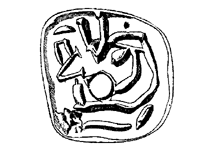
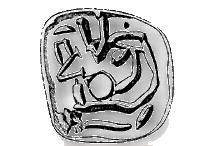
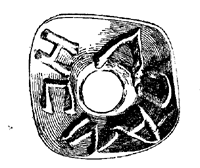
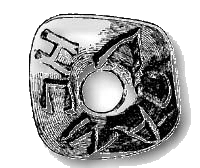
![]() Now, suppose the disk comes from Egypt. Seems a likely choice but we have nothing in Egypt that looks like it, either. Yet there is some evidence on the disk itself that points to Egypt. Look at the arrangements of some of the pictographs that have been identically repeated. For example, when we place a dot on each one of these 6 "arrow" signs (left) on side 1, and play silly connect-the-dots, we get something incredible. We connect the dots and up jumps --- a PYRAMID!
Now, suppose the disk comes from Egypt. Seems a likely choice but we have nothing in Egypt that looks like it, either. Yet there is some evidence on the disk itself that points to Egypt. Look at the arrangements of some of the pictographs that have been identically repeated. For example, when we place a dot on each one of these 6 "arrow" signs (left) on side 1, and play silly connect-the-dots, we get something incredible. We connect the dots and up jumps --- a PYRAMID!
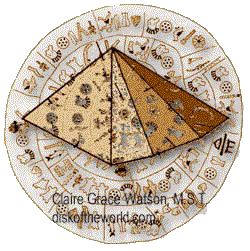
This method of disk decipherment is surely far beneath the dignity of most scholars and would-be decipherers but I have always enjoyed playing connect-the-dots in the Sunday paper. I don't know about you but I tend to suspect this pyramid of being the Great Pyramid, which may have been standing at least 1000 years before this disk was created. This pyramid was unexpected, wasn't it? You can imagine the excitement your decipherer felt when she happened upon it with tracing paper and a ruler.
Like decipherers everywhere, we get trapped in the spiral maze and go around and around and around until we finally transcend it. Or, like Icarus and the Maze of Daedalus, until we finally put on wings and fly out of it. From a height, we turn and look back and we see the hidden geometry on the disk. If we don't fly to close to the sun and melt our wings, we'll survive this Phaistos Disk decipherment. Get out some tracing paper and a ruler and connect every matching sign with every other like sign. All kinds of interesting images jump up from the spiral maze.
We have lifted a heavy veil in order to see this geometry that is hidden behind the spiraling pictographs. What other geometries may lurk in the hidden background, making all kinds of subliminal suggestions? We can only guess at what else is hidden, now that we know to look suspiciously on the disk as something capable of sneaking up on us. How did we get trapped in the spiral maze? We saw only the spiral and the pictographs, and we thought "circle, round, spiraling." We naturally did not think, "triangle, square, pyramid." Your decipherer is apparently the only person in nearly 100 years to see the disk and think "triangle, square, pyramid." She worries about that, but goes forward anyway.
![]() Time to compare this arrow, which we decipher to mean pyramid, with some other arrows found and identified by Sir Arthur Evans and see the similarities. The question is, what do these other arrows represent and is there a connection between this pyramid pictograph on the Phaistos Disk and the others arrows? Do the arrows identified by Evans mean "pyramid" and, if so, within what context?
Time to compare this arrow, which we decipher to mean pyramid, with some other arrows found and identified by Sir Arthur Evans and see the similarities. The question is, what do these other arrows represent and is there a connection between this pyramid pictograph on the Phaistos Disk and the others arrows? Do the arrows identified by Evans mean "pyramid" and, if so, within what context?
![]() Certainly, all this sailing back and forth from Crete to Egypt would make travel to the pyramid possible. And who knows? The Cretans were wealthy and leisurely. Did King and Queen Phaistos take a trip to see the Great Pyramid? Is the Phaistos Disk a record of the trip to the pyramid, a kind of pre-Hellenic postcard in clay? When they went to Egypt to see the pyramid, they went by boat. We know this because there was no other way to get there from Crete and because the record of the boat trip is also on the disk. When we connect all 15 star/fruit pictographs on side 2 of the disk, we can see the boat.
Certainly, all this sailing back and forth from Crete to Egypt would make travel to the pyramid possible. And who knows? The Cretans were wealthy and leisurely. Did King and Queen Phaistos take a trip to see the Great Pyramid? Is the Phaistos Disk a record of the trip to the pyramid, a kind of pre-Hellenic postcard in clay? When they went to Egypt to see the pyramid, they went by boat. We know this because there was no other way to get there from Crete and because the record of the boat trip is also on the disk. When we connect all 15 star/fruit pictographs on side 2 of the disk, we can see the boat.
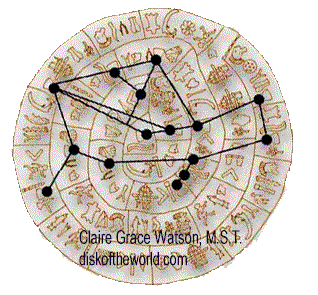


![]() If you think you can connect these dots however you like and get coherent images, try it and see what a jumble you get. There is only one way to connect all these like-signs, including them all and omitting none, to produce a discernible pattern. These big "picture writing" images seem to be about a boat trip to Egypt to see the pyramid. Perhaps we can now begin in the center of the disk and read the pictographs spiraling out, and see what we get. How about this, "In the Summer we hired some bald-headed sailors to row us to Egypt."
If you think you can connect these dots however you like and get coherent images, try it and see what a jumble you get. There is only one way to connect all these like-signs, including them all and omitting none, to produce a discernible pattern. These big "picture writing" images seem to be about a boat trip to Egypt to see the pyramid. Perhaps we can now begin in the center of the disk and read the pictographs spiraling out, and see what we get. How about this, "In the Summer we hired some bald-headed sailors to row us to Egypt."

![]()
![]() To continue with the next three signs, "But then we had to get out and walk through some wheat fields to finally arrive at the complex at Giza.
To continue with the next three signs, "But then we had to get out and walk through some wheat fields to finally arrive at the complex at Giza.
![]()
![]()
![]()
![]()

 "Then, we walked through some tall grasses and short shrubs, and we saw some animals being skinned, and with our guards protecting us, we saw what we came to see - a big star in the sky. Connect the 15 shields on side 1 to see the star surrounded by the shields, like...
"Then, we walked through some tall grasses and short shrubs, and we saw some animals being skinned, and with our guards protecting us, we saw what we came to see - a big star in the sky. Connect the 15 shields on side 1 to see the star surrounded by the shields, like...
the heaven of iron which he (Ptah/Zeus) had beaten into shape...The non-agricultural mountain-folk, who migrated hither and thither, knew naught of the corn-child. They conceived of a god who shaped the mountains with his hammer, the thunderbolt; each blow was a peal of thunder. He also hammered the sky into shape. Meteorites which fell from the sky were found to be of iron; it was consequently believed that the sky was formed of iron, which became known as 'the metal of heaven'. Iron was regarded as a protective charm. It was associated with the great deity who slew demons. A mortal had only to 'touch iron' to drive demons away, for by doing so he established a magical connection between himself and the hammer deity. (Mackenzie)("myths/intro.htm#iron")
See below the sky made of iron. Below that, the shield design for the Sky made of Iron, an enlargement of the shield held by the warrior on the Phaistos Disk.
He is profuse with holy symbols, which he seems to worship along with the gods whom they signify; first the shield, presumably as the emblem of his goddess in her warrior form; then the cross -- in both its Greek and its Roman shapes, and as the swastika -- cut upon the forehead of a bull or the thigh of a goddess, or carved upon seals, or raised in marble in the palace of the king; above all, the double ax, as an instrument of sacrifice magically enriched with the virtue of the blood that it sheds, or as a holy weapon unerringly guided by the god, or even as a sign of Zeus the Thundered cleaving the sky with his bolts. (The Life of Greece, Will Durant, 1939)
'Piracy
was an honourable occupation,' as one writer put it, 'and war the delight of
noble souls.' Some historians added, on the authority of Thucydides, that the commencement of Grecian civilization might be dated
from the reign of King Minos of Crete, who had cleared the Ægean Sea of pirates. (Mackenzie "myths/mc4.htm#pirates") 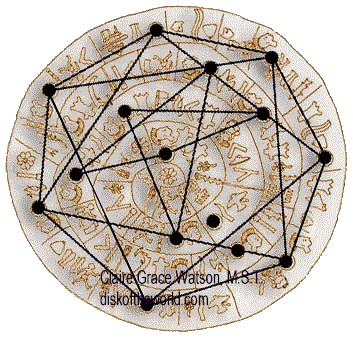




![]()
![]()
![]() Reading the next three pictographs, "Then, we took this trip again." One can follow this story as it continues, but it generates some questions requiring immediate research. For one thing, how is it that the boat is such an exact copy of the constellation Argo that each star/fruit is easily identified as a star in old Argo? Below it is a rudimentary version of it on steatite from an uncertain locality in Crete. In the basic version, the big star Canopus can be seen at the front of the boat. (and above, with the Phaistos Disk version beside it. This star sign is identifiable on many of the pictographs from Crete.)
Reading the next three pictographs, "Then, we took this trip again." One can follow this story as it continues, but it generates some questions requiring immediate research. For one thing, how is it that the boat is such an exact copy of the constellation Argo that each star/fruit is easily identified as a star in old Argo? Below it is a rudimentary version of it on steatite from an uncertain locality in Crete. In the basic version, the big star Canopus can be seen at the front of the boat. (and above, with the Phaistos Disk version beside it. This star sign is identifiable on many of the pictographs from Crete.)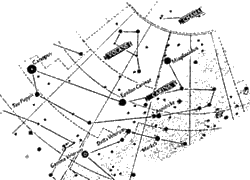
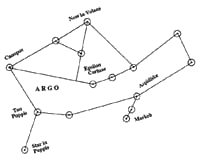
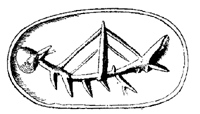
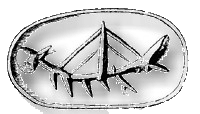
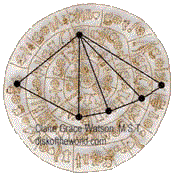
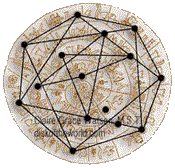 What is this Southern Hemisphere constellation doing on a Northern Hemisphere disk? You see the dilemma? As we lift a veil, another one takes its place, requiring research. And what about the sailor and that figure 8 on his cheek? Is that a tattoo? Why is he bald-headed? Is he "Bald Zeus," or is he like a Bronze Age pirate with a shaved head, a tattoo and an oar?
What is this Southern Hemisphere constellation doing on a Northern Hemisphere disk? You see the dilemma? As we lift a veil, another one takes its place, requiring research. And what about the sailor and that figure 8 on his cheek? Is that a tattoo? Why is he bald-headed? Is he "Bald Zeus," or is he like a Bronze Age pirate with a shaved head, a tattoo and an oar?
What about the complex ideogram of a pentagram inside a heptagon? Most people today do not know what it means, so how can we imagine that people 3,600 years ago knew how to draw this geometry? We would also have to suppose it meant something to them. Does it have the special meaning we give it today or is it just something they saw on their boat trip to Egypt?
And the pyramid! The drawing of the pyramid is exactly how, in geometry, to draw a 4-sided pyramid in a 2-dimensional space. How did they know to do that?
Although during the vast periods of the Neolithic, or Late Stone Age, there existed savage communities, just as happens to be the case at the present day in various parts of the world, there were also, as in Crete, Egypt, and Babylonia, refined and progressive peoples who were already 'heirs of all the Ages'. (Mackenzie "myths/intro.htm#progress")
Another heavy veil to lift involves the dating of the disk. It was found with a tablet marked with script and dated at about 1600 B.C.E. The tablet is sun-baked like all the other pottery artifacts whereas the disk is a ceramically fired anomaly and cannot be dated. With the excavations finished by 1903 by Evans and MacKenzie and others, the disk was found five years later. This is enough time for Donald Mackenzie, knowledgeable about Emanationism, which he calls Materialistic Monism ("myths/mc1.htm#monism"), to have returned home, created the disk and then returned to Phaistos to plant it there so that it would be found with the tablet and given a Bronze Age date. Far-fetched, certainly, but still the thought occurs, and Mackenzie says, regarding the Phaistos Disk,
In dealing with a mythology like that of Crete, which has not yet been
rendered articulate, for the script has still to be deciphered, we expect to
find traces of more than one stage of development in religious ideas, and also
of the ideas of settlers on the island of peoples from different cultural
centres. Certain relics suggest Egyptian influence and others point to an
intimate connection with archaic Grecian beliefs. No doubt Crete inherited much from Egypt; and
certain Greek States in which Cretan colonists settled borrowed much from Crete. (Mackenzie "myths/intro.htm#script")
Mackenzie continues, later on,
Emanationism or materialistic monism holds that the Universe is derived from one particular
form of matter, [which] has been called "Materialistic Monism". Ultimately, when mind
was exalted above matter, the belief obtained that the inanimate forces of
nature were subject to the control of the supreme Mind, which was the First Cause. This later doctrine is known as
"Idealistic Monism". It was embraced by various cults in Babylonia, India, and
Egypt.
In this context, the big star on the disk is the source from which all life is emanating. It is the great star from out of which pours all reality in spiraling patterns like DNA spirals.
Emanationism has strong roots in Egypt and extending down through the ages to produce the religious philosophy of Hermeticism. Figuring prominently in this Isis-Osiris mystery-myth are images seen on the Phaistos Disk: the constellation Argo is the Boat of Osiris (your decipherer was able to draw this boat by looking at a modern constellation map); the Star of Isis is the pentagram inside a heptagram (this was drawn by looking at the same image in mysticism called the Star of Isis); and the Great Pyramid, in which the cult was supposed to hold its initiations and observations of the stars and the heliacal rising of the star Sirius.
Donald Mackenzie was living during the early 20th century at the heighth of Hermeticism (Golden Dawn, H.P. Blavatsky, A.E. Waite, and many more). Mackenzie could have created the disk using a modern kiln to fire it. This disk tells the story of the birth of Isis and Osiris - the creation myth of Egypt. He then left it in Phaistos to be found later on, and his efforts would forever link these two civilizations together once the disk was deciphered by someone who recognized the images and symbols of ancient Egyptian Hermeticism.
Your decipherer, however, knows a great deal about ancient Hermeticism, thanks to finding these images on the disk and doing the consequent research, and she cannot be fooled by Mackenzie into thinking that this is an Isis-Osiris artifact. Although, admittedly, she did write five books based on such a decipherment. Click Find Osiris to read your author's decipherment based on Egyptian beliefs of the same period of time, 1600 B.C.E., regarding Isis and Osiris. Another decipherment by your author along these lines can be read Starlight Chronicles in which images from the disk are compared with images from the Egyptian Book of the Dead. Your decipherer has explored many possibilities and written about them, so she knows what all the other decipherers are going through in their Herculean task of lifting all these veils.
But another possibility exists regarding the fired disk. It may have been burned in the intense heat when the palace and surrounding buildings burned. Durant says,
Everywhere in the ruins Evans found signs of uncontrollable fire – charred beams and pillars, blackened walls, and clay tablets hardened against time's tooth by the conflagration's heat.
This would explain its status as a ceramically fired anomaly. Next, we can just assume that someone at Phaistos created the disk and that the picture writing is stylized Minoan picture writing. This way, we can attempt to decipher the disk as though it really is a Minoan artifact with Cretan pictographs all over it, some of them arranged like a boat, a pyramid and a star.
Any decipherment of a Minoan artifact might incorporate some or all of the legends and myths arising from this ancient civilization, but since Minoan Crete produced so many myths and legends, script would hardly suffice unless we could find walls and walls of it like Egyptian hieroglyphs. This decipherment you are reading relies on the images to be something other than a script, because they are found nowhere else and because the disk is so small that only a few sentences could be derived from a script decipherment, not entire myths and legends or lengthy revealments of a veiled civilization. But if the images are pictographs - a system of picture writing - then the pictures when placed in various arrangements might be very revealing, as we have seen, more so than an ancient script.
Picture writing and scripts were both used in the Mediterranean world during this time (3000 BCE - 1400 BCE).
Before real writing came picture-writing, such as is still practised by the Amerindians, the Bushmen, and savage and barbaric peoples in all parts of the world. It is essentially a drawing of things and acts, helped out by heraldic indications of proper names, and by strokes and dots to represent days and distances and such-like quantitative ideas. (Wells) ("wells/write1.htm#writing")
Sir Arthur Evans, excavator of Minoan Crete, went there to study the pictographs. He wrote the book Cretan Pictographs and Pre-Phoenician Script. One integral point your decipherer is making about picture writing vs. script is that a valid decipherment of the Phaistos Disk can involve pictographs rather than script, and this is right in line with what we know of this civilization. The decipherment you are reading takes the approach that the images are picture writing and that they can be read. And easily, as we have seen, just depending on your point of view. This is what makes all the decipherers so convinced they have deciphered the disk. They assign their value to the disk as a whole, then they use the picture writing to prove their decipherment, and the picture writing obliges them. It is an easy trap to fall into and a difficult one to climb back out of. For example, once your mind is made up that the disk is about a trip to Egypt to visit the pyramids, then each one of the pictographs can be seen to support this theory. And the ones that do not can easily be written off as difficult to decipher because this civilization is nearly lost to us.
Picture writing potentially can convey much more information about a civilization than a script can because it shows both the archetypal or universally understood elements of any civilization and also the elements of a specific civilization. Picture writing speaks to everyone, and this makes it a better method of communication than script for many reasons. Script is abstract and has to be learned, making script writing a part of the social, financial and political fabric of a civilization. Not everyone can understand script, and even today illiteracy rates are high even though we have to go to school to learn to read and write. But everyone can interpret picture writing. When one of the pictographs is deciphered or identified, then something about the civilization is deciphered or identified, and from this can come much information about the people, about how they lived their lives, what they believed in and how they expressed it. Arrange the pictographs differently, and they mean something different. Place them in certain geometrical arrangements and, again, the meaning changes.
Several pictographs can be placed in various arrangements to have different meanings. For example, various pictographs from the Phaistos Disk, when placed in different positions can mean different things. Using some that we recognize and some that don't, we can infer meaning. This of course invites interpretation, but inference is a part of picture writing. This is why so many different people have declared themselves the decipherer of the Phaistos Disk and believed it utterly. From their perspective and their learning, they really have deciphered it. So, depending upon our own socialization and perspective, we can get different meanings from the pictographs, depending on what we interpret them to mean and on what positions they are in. But, as Mackenzie says in his Myths of Crete and Pre-Hellenic Europe ("myths/preface.htm#explain"), and applied to this context,
The data summarized...emphasize the need for caution in attempting to solve a complex problem by the application of a hypothesis which may account for some resemblances but fails to explain away...
...other aspects of the disk.
When attempting a decipherment based on the disk's belonging to its own civilization, we have to lift another heavy veil - the confusion we have about the difference in a legend and a myth.
Legend applies particularly to a story associated with some period in the history of a people or nation, often containing an element of fact but sometimes wholly untrue. Legends are intended to glorify a hero, saint, object, etc., and tell marvelous deeds he or it supposedly performed. Myth applies particularly to a story connected with the religion of a primitive civilization. Myths are told about gods or superhuman beings and are invented to explain beliefs or rituals or something in nature. (The World Book Encyclopedia Dictionary)
Or as Mackenzie succinctly puts it, Myths are products of beliefs, and beliefs are products of experiences. ("myths/intro.htm#myths")
Minoan Crete, the civilization that your decipherer is assuming produced the disk, is long ago and far away and lives in our imaginations as either Neolithic blacksmiths working outside mud huts or brilliant architects, artisans and inventers living in Atlantean-style palaces. Maybe the truth is somewhere inbetween, but certainly there are two sets of stories their picture writing can convey, and it could be difficult to lift this veil - the myths of Crete and the legends of Crete and, sometimes, the blending of the two.
Sometime in the early history of humanity, myths/legends were traced in the stars, producing star groups and constellations to tell the stories. This method of producing defined star groups as constellations is an early form of picture writing, in which the ancients played connect-the-dots with the stars to produce specific designs that mean certain things. The stars are a good medium for picture writing - they stay the same over long periods of time. In fact, most of our constellation names come from Crete and Greece. It would therefore not be surprising to find constellations on the Phaistos Disk, and we have already seen an indication that more may be hidden on the disk, veiled by the spirals and the unique images. Some myths and legends of the Heroic Age associated with Crete might be played out in the stars:
Last but not least, whatever else the Phaistos Disk may be or may do, it is first and always a maze puzzle and not just because we are puzzled by it but because, on closer inspection, it reveals itself to be one. Perhaps the definition of an advanced civilization ought to be one that plays with its own myths and legends through drama, dance, astronomy and, in the case of Crete, maze puzzles.
The solution to a maze puzzle is the uninterrupted path from a starting point to a goal. Our starting point is a long time ago, in a place veiled by the mists of far away - the Aegean World of Bronze Age Crete. The goal is a deeper knowledge about this ancient civilization through the only artifact they left behind that is likely to tell us a great deal about them, maybe even double or triple what we already know about them. If we can identify pictographs on the Phaistos Disk, using everything we already know about Crete, using inference and using reason, rationality and research, then we can lift the final veil on a world that really is not in the dark past but exists as a bright and shining light. Hopefully, we will not get giddy with the thrill of thinking we have deciphered this ancient artifact but instead will stay on the spiraling path to learn more about the people who created it.